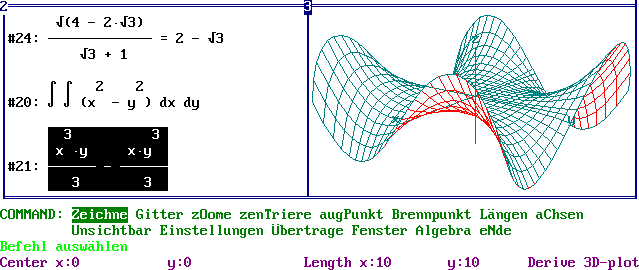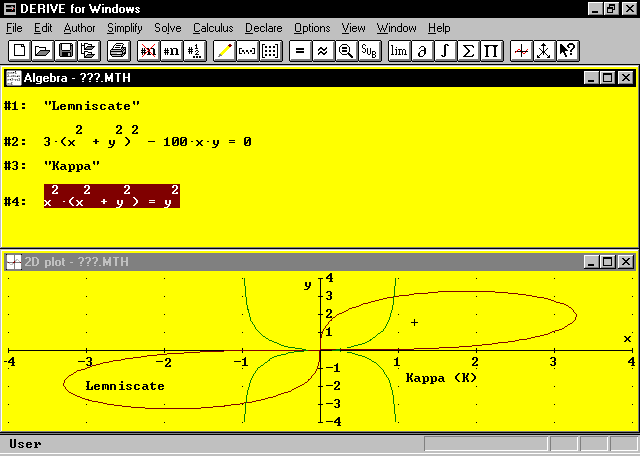
[ < ] [ globale Übersicht ] [ Kapitelübersicht ] [ Stichwortsuche ] [ > ]

Soft Warehouse, 3660 Waialae Avenue, Suite 304 Honolulu, Hawaii 96816-3236 U.S.A.
Soft Warehouse Europe, Softwarepark A-4232 Hagenberg, Austria
Version: |
Plattformen: |
Bezugsquellen: |
Studenten: |
Preis: |
CPU: |
RAM: |
HDD: |
| Derive f. Win |
|
|
|
|
386 | 8 MB | ? |
| Derive 3 |
|
|
|
|
286 | 512K | 500K |
| Derive XM |
|
|
? | $145.00 | 386 | 2 MB | ? |
Derive ist seit 1987 auf dem Markt und bietet mit der neuen 32-Bit Windows-Version
Berechnungsmöglichkeiten für Algebra, Gleichungen, Trigonometrie,
Vektoren, Matrizen und Analysis. Es ist wie Macsyma und Maple im universitären
Bereich entstanden. Die Entwicklung begann an der Universität von
Hawaii und wird nun von der Firma Softwarehouse
Inc. weitergeführt. Derive verfügt über keine richtige
Programmiersprache, eine stark eingeschränkte Programmierung mit sehr
wenigen Befehlen ist allerdings möglich. Ergebnisse lassen sich in
BASIC, Fortran, Pascal und C-Format abspeichern. Die Eingabe der Formeln
erfolgt in Textschreibweise, die Darstellung und die Ausgabe von Ergebnissen
im mathematischen Formelsatz. Die Ausgabezeilen sind sehr einfach über
Funktionstasten modifizierbar und problemlos auf einem Drucker auszugeben.
Alternativ läßt sich der Bildschirminhalt im TIFF-Format abspeichern.
Es ist immer wieder erstaunlich, zu welchen mathematischen Leistungen dieses
kleine Programm doch in der Lage ist. Die Bereiche Lineare Algebra und
Vereinfachung bereiten ihm keine Probleme, auch einzelne Gleichungen stellen
Derive nicht vor Schwierigkeiten. Ein Schwachpunkt ist das Fehlen eines
Befehls zur symbolischen Lösung von nichtlinearen Gleichungssystemen,
die nur 'zu Fuß' zu lösen sind.
Schwächen sind bei Summen und Reihen festzustellen.So erhält z.B. für die Taylorreihe und die unendliche Summe kein Ergebnis. Zur Berechnung von impliziten Ableitungen stellt Derive sogar eine Standardfunktion zur Verfügung. Die Integration und die Laplace Transformation ist nur zufriedenstellend. Derive stellt für die Laplace-Rücktransformation und die Fourier-Transformation keine Funktion zur Verfügung. Die Lösung von Differentialgleichungen ist zwar prinzipiell möglich; man muß dazu allerdings selbst deren Typ erkennen und die Gleichung in Normalform bringen. Funktionen zur Lösung von Differentialgleichungen sind damit eher für didaktische Zwecke geeignet. Im Vergleich zu anderen Systemen fallen die grafischen Möglichkeiten bescheiden aus. Derive zeichnet zwar alle Graphen korrekt, es existiert im Augenblick aber keine Funktion zur Darstellung von Vektorfeldern.
Zusammenfassend kann man sagen, daß Derive dem Anspruch, den man an ein Programm dieser Größe stellen darf, weit mehr als gerecht wird.
The Derive Internet Mailing List is a new electronic discussion list set up after the First International Derive Conference at Plymouth in July 1994. It covers matters relating to the computer algebra package Derive and its use in teaching. You can join by sending a message to mailbase@mailbase.ac.uk with the single line join derive-news firstname lastname as the text of the message. To contribute to the derive mailing list, send email to the address derive-news@mailbase.ac.uk. The bulletin is maintained by the CTI Centre for Mathematics and Statistics in Birmingham, UK.
Derive for Windows is a symbolic algebra program with 2D and 3D graphing capabilities. It is the ideal program for pre-algebra, algebra, trigonometry, precalculus, and calculus. You and your students can continue to use it for a variety of courses. No need to change programs and learn a new one each year.
Derive for Windows intelligently applied the rules of algebra, trigonometry, calculus, and matrix algebra to solve a wide range of mathematical problems. This non-numeric approach goes far beyond the capabilities of calculators, statistical packages and equation solves that use only approximate numerical techniques.
System Requirements: Windows 95, 3.1 or NT running on a computer with 8 megabytes of memory.
 Derive
Version 3 is a symbolic algebra program with 2-D and 3-D graphing capabilities
that runs on any PC compatible machine with just 512K of memory. It is
the ideal program for demonstration, research, and mathematical exploration.
Derive
Version 3 is a symbolic algebra program with 2-D and 3-D graphing capabilities
that runs on any PC compatible machine with just 512K of memory. It is
the ideal program for demonstration, research, and mathematical exploration.
Users appreciate the easy to use, menu-driven interface
Just enter a formula, using standard mathematical operators and functions. Derive will display it in an easy-to-read format using raised exponents and built up fractions. Select from the menu to simplify, plot, expand, factor, place over a common denominator, integrate, or differentiate.
Users applaud the power of Derive
Derive intelligently applies the rules of algebra, trigonometry, calculus, and matrix algebra to solve a wide range of mathematical problems. This non-numeric approach goes far beyond the capabilities of mere statistics packages and equation solvers that use only approximate numerical techniques. Powerful capabilities exist for 2D (Cartesian, polar, and parametric) and 3D graphing.
Systems Requirements:
Derive is available for PC compatible computers running MS-DOS or PC-DOS version 2.1 or later, or running the OS/2 operating system. The computer must have at least 512K of memory and one double sided (360K) 5 1/4" or (720K) 3 1/2" disk drive. Derive supports monochrome monitors, CGA, MCGA, MDA, EGA, VGA, and Hercules .
Derive Features:
Algebra
2-D plots ( rectangular and Cartesian) Implicit plots 3-D wire frame plots
Calculus
Finite and infinite symbolic limits, Antiderivatives and definite intergrals Taylor and Fourier series appproximations Exact first and second order ODE solving Vectors &Matrices
"Industrial strength" Derive XM is identical to the original, menu-driven program providing the same features and functions for solving symbolic and numeric problems in algebra, trigonometry, calculus, and matrix algebra. In addition, Derive XM can make use of up to 4 gigabytes of extended memory to solve much larger problems. Derive XM requires a 386 or 486 based PC compatible computer with 2 or more megabytes of extended memory. It comes with a 3.5 inch 720K disk and a manual.
| Programming | Arithmetic | Algebra |
| Functions | Calculus | Vectors and Matrices |
| Input/Output | Menu-Driven Interface |
[ < ] [ globale Übersicht ] [ Kapitelübersicht ] [ Stichwortsuche ] [ > ]